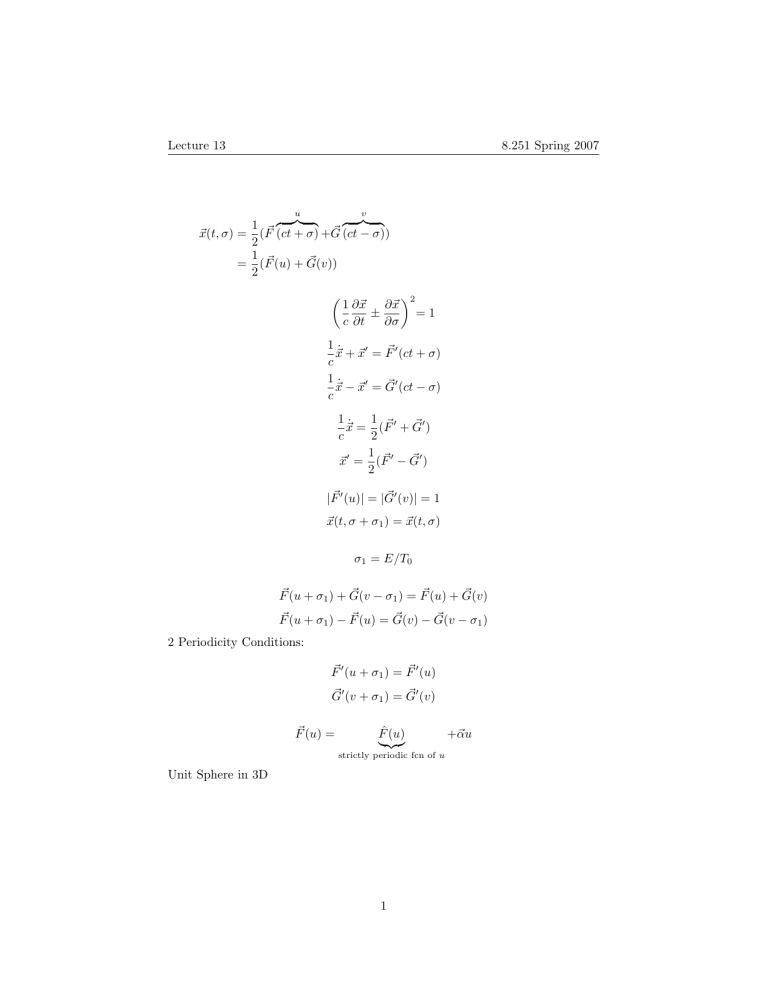Document 13614761
advertisement

Lecture 13 8.251 Spring 2007 u v 1 � �� � � � �� � �x(t, σ) = (F� (ct + σ) +G (ct − σ)) 2 1 � (v)) = (F� (u) + G 2 � 1 ∂�x ∂�x ± c ∂t ∂σ �2 =1 1 �ẋ + �x� = F� � (ct + σ) c 1 � � (ct − σ) �ẋ − �x� = G c 1 1 � �) �ẋ = (F� � + G c 2 1 � �) �x� = (F� � − G 2 � � (v)| = 1 |F� � (u)| = |G �x(t, σ + σ1 ) = �x(t, σ) σ1 = E/T0 � (v − σ1 ) = F� (u) + G � (v) F� (u + σ1 ) + G � (v) − G � (v − σ1 ) F� (u + σ1 ) − F� (u) = G 2 Periodicity Conditions: F� � (u + σ1 ) = F� � (u) � � (v + σ1 ) = G � � (v) G F� (u) = F̂ (u) � �� � strictly periodic fcn of u Unit Sphere in 3D 1 αu +� Lecture 13 8.251 Spring 2007 F� � is a unit vector (so goes from origin to surface). Traces a closed curve on surface, periodic. � � traces another curve G Usually, these paths cross at least two times at point (u0 ,v0 ) subject to F� � (u0 ) = � � (v0 ). G (u0 , v0 ) determines (t0 , σ0 ). � � (v0 )) = F� � (u0 ) Thus 1c �ẋ(t0 , σ0 ) = 12 (F� � (u0 ) + G 2 Lecture 13 8.251 Spring 2007 |�ẋ(t0 , σ0 )| = c|F� � (u0 )| = c At one point at a time, string moving at speed of light! 1 � � (v0 )) �x� (t0 , σ0 ) = (F� � (u0 ) − G � �� � 2 0 What does the string look like at this time t0 at positions near σ0 ? 0 � �� � 1 x(t0 , σ ≈ σ0 ) = x(t0 , σ0 ) + (σ − σ0 ) · x� (t0 , σ0 ) + (σ − σ0 )2 x�� (t0 , σ0 ) + . . . 2 2� = x�0 + (σ − σ0 ) T0 + . . . where T�0 = 12 x�� (t0 , σ0 ) etc. String has cusp singularity. Align xy axis subject to: 2 Find y ≈ |x| 3 Imagine string survived early universe, very long (across universe), with lots of tension, gigantic µ0 . What would happen if crossing the room? We wouldn’t feel any gravitational attraction! Einstein’s gravity says sometihng with mass will gravitate. But the µ0 and the tension conspire to make no gravity. 3 Lecture 13 8.251 Spring 2007 Does affect geometry of space. If measure radisu of string and go in same radius circle around, don’t get circumference/radius = 2π. Creates a conical singularity! Conical singularity of a cosmic string ∃ ongoing searches for these. False alarm 1.5 years ago. Deficit angle: δ = 8πGT0 /c4 = 8πGµ0 /c2 . µ0 = T0 /c2 . 2 Recall G = hc/M ¯ ¯ c. Construct now p . Mp : Planck Mass. Got Mp from G, h, Mp from µ0 , h̄, c. [µ0 ] = M/L [t] = M L2 /T = M L[c] [µ0 ] = M/[h̄][c] = M 2 [c]/[h̄] So µ0 = Ms2 c/h̄. Ms is string mass. � µs δ = 8π µp �2 δ ≈ 5.2”(Gµ0 /10−6 ). ”: seconds or arc, c = 1. Example: If knew δ = 0.5�� , µ0 = 1.3 × 1020 kg/m. Can look for δ See 2 images with angle between. What is Pµσ ? Recall Maxwell: � · E = ρ. � × B = 1c J� + � =0 � · (� × B) 4 � 1 ∂E c ∂t . (for any B) Lecture 13 8.251 Spring 2007 1 1 ∂� · E � · J� + =0 c c ∂t ∂ρ � · J� + =0 ∂t Charge Conservation: 1 ∂ (ρc) + ∂i J i = 0 c ∂t ∂ µ J =0 ∂xµ Define Charge: � Q= dQ = dt � d3 xρ(t, �x) d3 xdρ(t, �x)/dt = − � d3 x� · J� = − � d�a · J� ρ: charge density Q/L3 (density over volume) J�: current density Q/T L2 (density over area) Mechanics Lagrangian: L(q(t), q̇(t); t) Symmetry: a rule to change any path q(t) subject to L is unchanged. There exists other kinds of symmetries too. Rule may depend on path. Rule: q(t) → q(t) + δq(t) where δq(t) = � · h(q(t); t). h is a magic function. �: small number. Accordingly: d (δq(t)) dt Theorem: If under these changes the terms linear is δq vanish in δL, then we get a conserved charge: � � ∂L �Q = δq ∂q̇ q̇(t) = q(t) + Claim: dQ dt =0 � � d d ∂L ∂L d (�Q) = (δq) δq + dt dt ∂q̇ ∂q̇ dt Euler Lagrange Equation of Motion: 5 Lecture 13 8.251 Spring 2007 � � ∂ ∂L ∂L − =0 ∂t ∂q ∂� Used to write: d(EQ) = dt � � � � ∂L ∂L δq + δq̇ = δL = 0 ∂q ∂q̇ Example: L = L(q̇(t)). L only dependent on velocity. Then have symmetry δq(t) = �. The have δq̇ = 0. L invariant (so is symmetric). Q= � S= ∂L =p ∂�˙ dξ 0 dξ 1 . . . dξ p L(φa , ∂α φa ) α → 0, . . . , p a Fields: φ . Nambu-Gotta: α ξ (τ, σ) = � � dτ � µ ∂x ∂xµ dσL , ∂τ ∂σ Will find there are conserved currents of form 6 ∂ α ∂ξ α (Ji )





